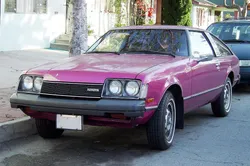

Toyota Celica Generation 2 A40 A50 Overview
Explore the Toyota Celica generation, focusing on the second generation A40 and A50 models. Discover their features and specifications, especially in Portugal.
The Toyota Celica is a nameplate synonymous with sportiness, versatility, and performance in the compact car segment. Spanning a variety of generations, each iteration has left a mark on the automotive ...
Technical Specifications
Select Version
Dimensions
Engine
Driving
Others
History and Features
Mycarro AI
Apr 27, 2025
The Toyota Celica is a nameplate synonymous with sportiness, versatility, and performance in the compact car segment. Spanning a variety of generations, each iteration has left a mark on the automotive landscape. The second generation of the Celica, encompassing models A40 and A50, was produced from 1982 to 1985. This period marked significant advancements in design, technology, and performance, solidifying the Celica's reputation as a stylish and affordable sports coupe.
Design and Engineering Enhancements
The second-generation Toyota Celica underwent a considerable redesign, which incorporated more aggressive styling cues that were indicative of the era's automotive trends. The A40 series featured a longer, wider body than its predecessor, contributing to a more planted stance on the road. The design introduced sharp creases and defined lines, emphasizing the sporty character of the vehicle while maintaining a level of elegance. The model offered both coupe and liftback versions, catering to diverse consumer preferences.
In addition to aesthetics, engineering refinements played a crucial role in the second-generation Celica's development. The A40/A50 generation was built on an updated platform that enhanced ride quality and handling performance. Toyota's focus on unibody construction resulted in a car that was both lighter and stiffer, improving overall driving dynamics. The improvements in engineering would become a benchmark for future Celica models and establish a legacy of performance-focused design.
Engine Options and Performance
Throughout its production run, the second-generation Celica offered a range of engine options tailored to varying performance needs. The base model was equipped with a 1.6-liter inline-four engine, delivering reliable but modest power. However, enthusiasts were more drawn to the performance-oriented models, which featured either a 2.0-liter engine or a turbocharged variant. The full specifications included up to 135 horsepower, which was significant at the time and allowed for exhilarating acceleration and sporty responsiveness.
The Celica's rear-wheel-drive layout further contributed to its reputation as a spirited driving machine. This configuration offered keen handling characteristics, making it popular in motorsports, particularly in rallying. Its combination of lightweight construction and robust engine performance made the second-generation Celica a perfect candidate for enthusiasts seeking both practicality and performance.
Interior Quality and Comfort
Inside, the Toyota Celica offered a driver-centric approach, featuring a clean dashboard layout that emphasized functionality. The cabin was equipped with comfortable seating for four passengers, making it suitable for daily use while maintaining its sporty character. Standard features included a cassette player and optional upgrades such as air conditioning and premium audio systems, which elevated the driving experience during long journeys.
The liftback variant, which provided increased cargo space, was particularly popular among buyers seeking practicality without sacrificing sportiness. The ease of access to the cargo area was a notable selling point, appealing to younger buyers who desired a mix of style and everyday utility.
Market Influence and Legacy
The second generation Celica played a pivotal role in Toyota's expansion in the North American market during the 1980s. It successfully captured the interest of young drivers and automotive enthusiasts, appealing through its combination of style, affordability, and performance. The Celica became a prominent entry-level sports car, influencing competitors and setting the stage for the future iterations of the model line.
As the automotive landscape evolved, so did the Celica. However, the impact of the A40 and A50 generations on sports coupe design and performance standards continued to resonate in subsequent models. These generations laid a foundation for iconic performance variants, like the Celica GT-Four, and strengthened Toyota's standing within the automotive community.
Conclusion
The Toyota Celica Generation 2 (A40/A50) remains a crucial part of automotive history. Celebrated for its innovative design, solid engineering, and affordability, it successfully bridged the gap between compact cars and sports coupes. Today, it is recognized not only for its nostalgic appeal but also as an embodiment of Toyota's commitment to delivering quality vehicles that resonate with drivers of all ages. The legacy of the Celica continues to inspire admiration, making it a sought-after classic among enthusiasts and collectors alike.
